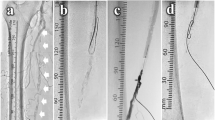Abstract
Introduction
Obstructions of the supraaortic vessels are an important cause of morbidity associated with a variety of symptoms. Percutaneous transluminal angioplasty has evolved as an effective and safe treatment modality for occlusive lesions of the supraaortic vessels. However, the endovascular management of an innominate bifurcation has not previously been reported.
Methods
A 53-year-old female with a history of systematic hypertension, diabetes mellitus and hypercholesterolemia presented with left hemiparesis and dysarthria. Angiography of the innominate artery showed a stenosis of the innominate bifurcation.
Results
The lesion was successfully treated using the retrograde kissing stent technique via a brachial approach and an exposed direct carotid approach.
Conclusion
The retrograde kissing stent technique for the treatment of a stenosis of the innominate bifurcation was found to be a safe and effective alternative to conventional surgery.




Similar content being viewed by others
References
Hadjipetrou P, Cox S, Piemonte T, et al (1999) Percutaneous revascularization of atherosclerotic obstruction of aortic arch vessels. J Am Coll Cardiol 33:1238–1245
Tsutsumi M, Kazekawa K, Kodama T, et al (2003) Retrograde carotid stenting for isolated stenosis of the proximal common carotid artery. Neurol Med Chir (Tokyo) 43:546–549
Sidhu PS, Morgan MB, Walters HL, et al (1998) Technical report: Combined carotid bifurcation endarterectomy and intra-operative transluminal angioplasty of a proximal common carotid artery stenosis: an alternative to extrathoracic bypass. Clin Radiol 53:444–447
Harada K, Nakahara I, Tanaka M, et al (2004) Therapeutic strategy and outcome of stenting for subclavian and innominate artery occlusive disease. No Shinkei Geka 32:151–158
Ringelstein EB, Zeumer H (1984) Delayed reversal of vertebral artery blood flow following percutaneous transluminal angioplasty for subclavian steal syndrome. Neuroradiology 26:189–198
Brountzos EN, Petersen B, Binkert C, et al (2004) Primary stenting of subclavian and innominate artery occlusive disease: a single center’s experience. Cardiovasc Intervent Radiol 27:616–623
Gonzalez A, Gil-Peralta A, Gonzalez-Marcos JR (2003) Angioplasty and stenting for total symptomatic atherosclerotic occlusion of the subclavian or innominate arteries. Cerebrovasc Dis 13:107–113
Bruckmann H, Ringelstein EB, Buchner H, et al (1986) Percutaneous transluminal angioplasty of vertebral artery: a therapeutic alternative to operative reconstruction of proximal vertebral artery stenoses. J Neurol 233:336–339
Tanaka M, Taki W, Miyamoto S, Nakahara I, Sadato A, Matsumoto K, Kikuchi H (1994) Percutaneous transluminal angioplasty (PTA) for stenosis at subclavian artery and the origin of vertebral artery: therapeutic indication and some adjunctive safe methods during PTA. No Shinkei Geka 22:939–946
Haulon S, Mounier-Vehier C, Gaxotte V, et al (2002) Percutaneous reconstruction of the aortoiliac bifurcation with the “kissing stents” technique: long-term follow-up in 106 patients. J Endovasc Ther 9:363–368
Mohamed F, Sarkar B, Timmons G, et al (2002) Outcome of “kissing stents” for aortoiliac atherosclerotic disease, including the effect on the non-diseased contralateral iliac limb. Cardiovasc Intervent Radiol 25:472–475
Saker MB, Oppat WF, Kent SA, et al (2000) Early failure of aortoiliac kissing stents: histopathologic correlation. J Vasc Interv Radiol 11:333–336
Conflict of interest statement
We declare that we have no conflict of interest.
Author information
Authors and Affiliations
Corresponding author
Rights and permissions
About this article
Cite this article
Nagata, Si., Kazekawa, K., Matsubara, S. et al. Percutaneous reconstruction of the innominate bifurcation using the retrograde ‘kissing stents’ technique. Neuroradiology 48, 537–540 (2006). https://doi.org/10.1007/s00234-006-0090-3
Received:
Accepted:
Published:
Issue Date:
DOI: https://doi.org/10.1007/s00234-006-0090-3




